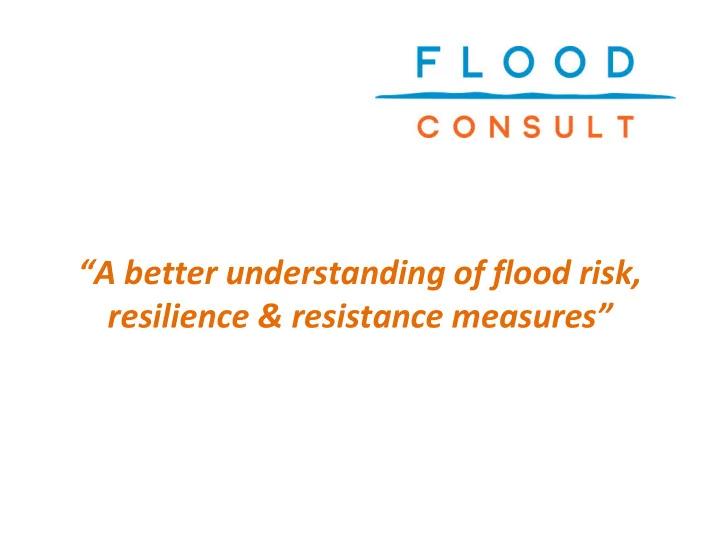

“A better understanding of flood risk, resilience & resistance measures”
Carlisle Flood Events 4.5 4 4 4 4 3.5 3 2.5 Frequency 2 2 Flood Events 2 1.5 1 1 1 0.5 0 1890 ‐ 1910 1910 ‐ 1930 1930 ‐ 1950 1950 ‐ 1970 1970 ‐ 1990 1990 ‐ 2010 2010 ‐ 2015 Time Period
York Flood Events 6 5 5 5 4 4 4 Frequency 3 3 Flood Events 2 1 1 0 0 1890 ‐ 1910 1910 ‐ 1930 1930 ‐ 1950 1950 ‐ 1970 1970 ‐ 1990 1990 ‐ 2010 2010 ‐ 2015 Time Period
Texas Flood ‐ Hurricane Harvey Around 150 trillion litres of water was left behind by the hurricane, four times the amount left by Hurricane Katrina in 2005. 28000 square miles of Houston was flooded adding around 137.5 billion tons to the landmass of the southern US region. GPS data collected from stations around Houston detected the area had been depressed 2cm under the weight of the water deposited by Harvey.
November 2019 Floods – Mid and North England Heavy persistent rainfall across Nottinghamshire, Derbyshire & South Yorkshire in the order of 1.6% (1 in 60) probability following an exceptionally wet autumn where more than twice the average rainfall was recorded. Sheffield and Doncaster receive their November average rainfall in a 24 hour period, Sheffield 82mm and Doncaster 78mm. Gringley ‐ on ‐ the ‐ Hill in Nottinghamshire records 63.2mm in 24 hours, 122% of the November average rainfall. Flows on the River Don in Doncaster exceed 0.4% (1 in 250) probability (new record), Sheffield less than 1% (1 in 100), Derwent in Derby less than 1% (1 in 100). Over 1750 homes and businesses throughout South Yorkshire, Derbyshire, Nottinghamshire & Lincolnshire flooded.
River Thames Tidal Barrier Closures The Thames Barrier has been closed 184 times since it became operational in 1982 (correct as of March 2019). Of these closures, 97 were to protect against tidal flooding and 87 were to protect against combined tidal/fluvial flooding. The barrier closed more times in February 2014 (28) than the previous record for a whole winter (24 in 2000 ‐ 01). The Thames Barrier closed 50 times in 2014 ‐ already a record for a single year. This period of closures is comparable to 40% of the total closures from when operation began in 1982.
Background • Critical National Infrastructure (CNI) • Determine flood risk at a site specific level • Provide flood resilience/resistance measures
Site Specific Flood Risk • Based on the best available data • Fluvial, pluvial or coastal/tidal and combinations • EA, SEPA, NRW & Local Authorities
Onsite Survey • Site specific GPS ground level survey • Identify critical/vulnerable assets • Provide flood resilience/resistance measures • Recommend competent companies
Flood Mechanisms • Primary Natural Mechanisms • Fluvial (Rivers) • Coastal/Tidal (Sea) • Pluvial (Surface Water) • Primary Artificial Mechanisms • Reservoir Breach/Dam Break • Canal Failure • Secondary Mechanisms • Groundwater (Rising Water Table) • Sewer Flooding
Fluvial Flooding • Prolonged, heavy rainfall in the catchment. • Flow of the natural river channel is exceeded. • Water overspills on the surrounding land. • Duration: up to several weeks • Flood warning given days in advance.
Coastal/Tidal Flooding • Combination of weather elements: low pressure, driving winds, astronomic tides. • Weather elements cause the sea surface to rise (storm surge). • Storm surge overwhelms low lying coastlines. • Duration: peak storm surge can last up to 2 hours. • Flood warning given days in advance.
Pluvial (Surface Water) Flooding • Prolonged heavy rainfall or extreme sudden bursts (cloud burst). • Natural ground drainage and local drainage network overwhelmed. • Surplus water pools on the ground surface. • Duration: usually up to 30 minutes • Flood warning not given due to spontaneity of events.
Flood Defence Techniques Flood Resistance ‐ A flood resistant building is constructed in such a way to prevent entry of water in to the structure and damaging its fabric/contents. Flood Resilience ‐ A flood resilient building is designed and constructed to reduce the impact of flood water entering the building so that no permanent damage is caused, structural integrity is maintained and drying and cleaning is easier.
Entrance point protection
Entrance point protection
Flood glazing doors and window
Cable Entry Sealing
Sealing Cable Entries Example
Sealing Cable Entries Example
Vents / Pumps
Non Return Valves
Flood Membrane Example
Flood Proof Cabinets Example
Flood Proof Cabinets Example
Flood Gate Examples
Demountable Barrier Systems – Permanent Foundation
Demountable Barrier Systems – No Foundation
Demountable Barrier System – Case Study
Onsite Flood Testing Examples
Flood Resilience • Flooring • Avoid the use of carpets, wooden or water absorbent materials • Use ceramic tiles, vinyl or painted flooring where possible • Retractable rugs instead of carpet • Walls • Avoid standard gypsum based plaster or water absorbent materials • Use lime based plaster, cement render or plastic superficial sheeting • Planning • Create a flood plan which can include: o Moving vulnerable contents o Turning off utilities o Installing flood protection measures o Create a safe route of egress o Plan property reoccupation
Recommend
More recommend